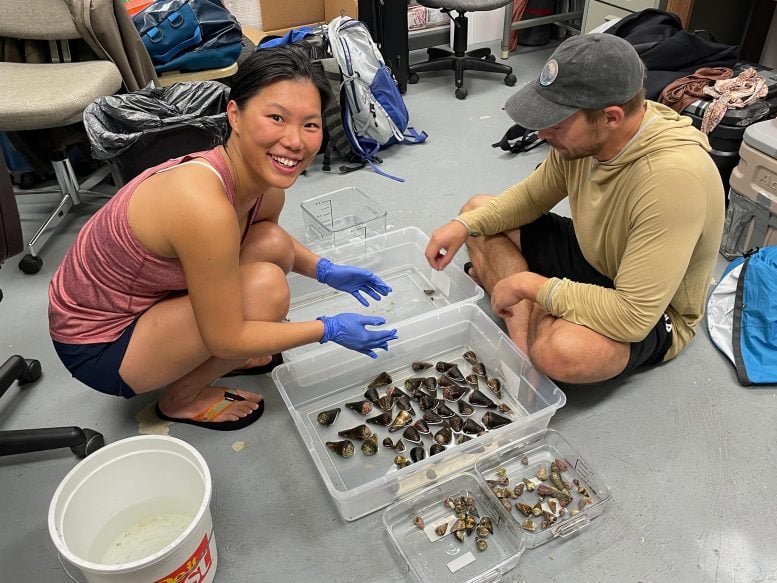
Posted on 08/26/2024 5:14:06 AM PDT by Red Badger
Cone snail venom contains consomatin, a toxin that could lead to better, longer-lasting drugs for diabetes and hormone-related diseases by mimicking somatostatin.
A new study published in Nature Communications reveals the toxin from one of the most venomous animals on the planet may hold the key to improving drugs for diabetes and hormone disorders.
An international team of scientists led by the University of Utah identified a component within the venom of a deadly marine cone snail, the geography cone, that mimics a human hormone called somatostatin, which regulates the levels of blood sugar and various hormones in the body. The hormone-like toxin’s specific, long-lasting effects, which help the snail hunt its prey, could also help scientists design better drugs for hormone disorders and diabetes.

Ho Yan Yeung, PhD, first author on the study (left) and Thomas Koch, PhD, also an author on the study (right) examine a freshly-collected batch of cone snails. Credit: Safavi Lab Blueprint for Better Drugs
The somatostatin-like toxin the researchers identified could provide invaluable insights into new medications for diabetes and hormone disorders.
Somatostatin acts like a brake pedal for many processes in the human body, preventing blood sugar, various hormones, and many other important molecules from rising to dangerously high levels. The researchers found the cone snail toxin, called consomatin, works similarly, —but consomatin is more stable and specific than the human hormone, which makes it a promising blueprint for drug design.
By measuring how consomatin interacts with somatostatin’s targets in human cells in a dish, the researchers found that consomatin interacts with one of the same proteins that somatostatin does. But while somatostatin directly interacts with several proteins, consomatin only interacts with one. This fine-tuned targeting means that the cone snail toxin affects hormone levels and blood sugar levels but not the levels of many other molecules.
In fact, the cone snail toxin is more precisely targeted than the most specific synthetic drugs designed to regulate hormone levels, such as drugs that regulate growth hormone. Such drugs are an important therapy for people whose bodies overproduce growth hormones. Consomatin’s effects on blood sugar could make it dangerous to use as a therapeutic, but by studying its structure, researchers could start to design drugs for endocrine disorders that have fewer side effects.
Consomatin is more specific than top-of-the-line synthetic drugs—and it also lasts far longer in the body than the human hormone, thanks to the inclusion of an unusual amino acid that makes it difficult to break down. This is a useful feature for pharmaceutical researchers looking for ways to make drugs that will have long-lasting benefits.
Learning from Cone Snails
Finding better drugs by studying deadly venoms may seem unintuitive, but Helena Safavi, PhD, associate professor of biochemistry in the Spencer Fox Eccles School of Medicine (SFESOM) at the University of Utah and the senior author on the study, explains that the toxins’ lethality is often aided by pinpoint targeting of specific molecules in the victim’s body. That same precision can be extraordinarily useful when treating disease.
“Venomous animals have, through evolution, fine-tuned venom components to hit a particular target in the prey and disrupt it,” Safavi says. “If you take one individual component out of the venom mixture and look at how it disrupts normal physiology, that pathway is often really relevant in disease.” For medicinal chemists, “it’s a bit of a shortcut.”
Ho Yan Yeung, PhD, first author on the study, hunts for venomous sea snails in the shallow reefs of Palau. Credit: Safavi Lab
Consomatin shares an evolutionary lineage with somatostatin, but over millions of years of evolution, the cone snail turned its own hormone into a weapon.
For the cone snail’s fishy prey, consomatin’s deadly effects hinge on its ability to prevent blood sugar levels from rising. And importantly, consomatin doesn’t work alone. Safavi’s team had previously found that cone snail venom includes another toxin that resembles insulin, lowering the level of blood sugar so quickly that the cone snail’s prey becomes nonresponsive. Then, consomatin keeps blood sugar levels from recovering.
Evolutionary Insights from Cone Snails
“We think the cone snail developed this highly selective toxin to work together with the insulin-like toxin to bring down blood glucose to a really low level,” says Ho Yan Yeung, PhD, a postdoctoral researcher in biochemistry in SFESOM and the first author on the study.
The fact that multiple parts of the cone snail’s venom target blood sugar regulation hints that the venom could include many other molecules that do similar things. “It means that there might not only be insulin and somatostatin-like toxins in the venom,” Yeung says. “There could potentially be other toxins that have glucose-regulating properties too.” Such toxins could be used to design better diabetes medications.
It may seem surprising that a snail is able to outperform the best human chemists at drug design, but Safavi says that the cone snails have evolutionary time on their side. “We’ve been trying to do medicinal chemistry and drug development for a few hundred years, sometimes badly,” she says. “Cone snails have had a lot of time to do it really well.”
Or, as Yeung puts it, “Cone snails are just really good chemists.”
Reference: “Fish-hunting cone snail disrupts prey’s glucose homeostasis with weaponized mimetics of somatostatin and insulin” by Ho Yan Yeung, Iris Bea L. Ramiro, Daniel B. Andersen, Thomas Lund Koch, Alexander Hamilton, Walden E. Bjørn-Yoshimoto, Samuel Espino, Sergey Y. Vakhrushev, Kasper B. Pedersen, Noortje de Haan, Agnes L. Hipgrave Ederveen, Baldomero M. Olivera, Jakob G. Knudsen, Hans Bräuner-Osborne, Katrine T. Schjoldager, Jens Juul Holst and Helena Safavi-Hemami, 20 August 2024, Nature Communications.
Just so long as spiders aren’t involved, I’m ok with it.
From the article: It may seem surprising that a snail is able to outperform the best human chemists at drug design...
_______________
Maybe a Better Chemist Designed it?
Many different spider venoms are being studied for their health-related effects.............
I’ve just had a kitty cat turn up as diabetic. She wasn’t fat, very active. So odd that it should happen. I hope they figure out a cure - for both humans & animals - soon.
Just killed a 5 inch spider in my garage. It had stiff stick legs. It was moving too fast and hiding in cracks. I sprayed him with insect killer. That slowed the creature enough to smash him with shoe.
‘Zackley!....................
*
I hear of that happening more and more. It’s sad because we love our little furry creatures.
Where there is one, there are thousands, taking notes and studying your blind spots. They just watched you smash one of their scouts. You are now a blood enemy. Best to burn your garage now while you still can. If your local zoning allows it, use one of your tactical nukes to be sure.
It’s probably a good thing for us that spiders don’t wear shoes...
I am in Florida. I have had visits from 6 foot long snakes, black bears, scorpions, and there are 3 gators in the 3 ponds in my subdivision. I ain’t scared of spiders. Actually spiders eat mosquitoes and other bugs. But I have no defense against fire ants. Those are everywhere in my yard. They bite and it burns and gets infected. Those are the only creatures I am really afraid of. I use hydrogen peroxide dab frequently on fire ant bites. It reduces itching and heals the infection after I pop the blisters.
The good news is it will control your diabetes so you can eat all the sweets you like. The bad news is it’s a neurotoxin so you’ll be paralyzed while you are taking it.

Disclaimer: Opinions posted on Free Republic are those of the individual posters and do not necessarily represent the opinion of Free Republic or its management. All materials posted herein are protected by copyright law and the exemption for fair use of copyrighted works.